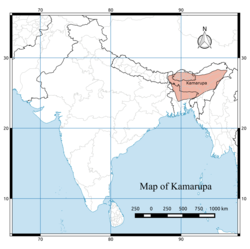
Back বৰ্মণ ৰাজবংশ Assamese বর্মণ রাজবংশ Bengali/Bangla Dinastia Varman Catalan Dynastie Varman French वर्मन राजवंश Hindi ವರ್ಮನ್ ರಾಜವಂಶ Kannada वर्मन राजघराणे Marathi Варман Russian Varman (dinastija) Serbo-Croatian வர்மன் அரசமரபு Tamil
Kamarupa Kingdom Varman dynasty | |||||||||
|---|---|---|---|---|---|---|---|---|---|
| 350 CE–655 CE | |||||||||
 The traditional map of Kamarupa. | |||||||||
| Capital | Pragjyotishpura | ||||||||
| Official languages | Sanskrit, Kamarupi Prakrit | ||||||||
| Religion | Hinduism, Tribal religion[1] | ||||||||
| Government | Monarchy | ||||||||
| Maharajadhiraja | |||||||||
• c. 350 – c. 374 | Pushyavarman | ||||||||
• c. 518 – c. 542 | Bhutivarman | ||||||||
• c. 600 – c. 650 | Bhaskaravarman | ||||||||
| Historical era | Classical India | ||||||||
• Established | 350 CE | ||||||||
• Disestablished | 655 CE | ||||||||
| |||||||||
| Part of a series on the |
| History of Assam |
|---|
 |
| Categories |
The Varman dynasty (350–650) was the first historical dynasty of the Kamarupa kingdom. It was established by Pushyavarman, a contemporary of Samudragupta.[2][3] The earlier Varmans were subordinates of the Gupta Empire,[4] but as the power of the Guptas waned, Mahendravarman (470–494) performed two horse sacrifices and the status of Kamarupa as an independent state remained unimpaired.[5] As per the Apsad Inscription of Adityasen, Susthivarman was defeated by Mahasengupta on the bank of Lauhitya.[6] The first of the three Kamarupa dynasties, the Varmans were followed by the Mlechchha and then the Pala dynasties.[7]
- ^ (A)ccording to the Yogina Tantra—a product of seventeenth-century Assam—the entire religion of Kamarupa is itself described as kirata dharma, that is, the religion of the northeast hill tribes,."(Urban 2011, p. 237)
- ^ Sharma (1978), p. xxix.
- ^ Cite error: The named reference
:3was invoked but never defined (see the help page). - ^ Majumdar, Ramesh Chandra; Altekar, Anant Sadashiv (1986). Vakataka – Gupta Age Circa 200-550 A.D. Motilal Banarsidass Publ. p. 142. ISBN 9788120800267.
- ^ Sen, Sailendra Nath (1999). Ancient Indian History and Civilization. New Age International. p. 303. ISBN 978-81-224-1198-0.
The status of Kamarupa remained unimpaired as the grandson of Bhutivarman also performed two Asvamedha sacrifices
- ^ Maity. Sachindra Kumar. Corpus Of Bengal Inscriptions Bearing On History And Civilization Of Bengal. p. 7.
Again the Apsad Inscription of Adityasen refer to his grandfather Mahasengupta's defeat of Susthivarmand on the bank of Lauhitya. Susthivarman was the King of Kamarupa
- ^ Sircar, D C (1990), "Political History", in Barpujari, H K (ed.), The Comprehensive History of Assam, vol. I, Guwahati: Publication Board, Assam, pp. 94–171